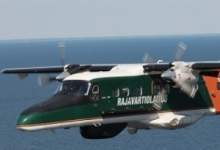

Some years back, the Baltic Sea had something of a reputation as being a cradle for oil spills.The figures speak for themselves. According to statistics reported by the Finnish Environment Institute (SYKE), in 2001, a record number of 107 spills were reported, with each slick accounting for roughly 180 litres.
For some time, the justification for such fallibility was simple. It went as follows: in waters defined by high levels of marine traffic and shipping, oil spills are inevitable.
But in the subsequent years, a remarkable transformation has taken place in Baltic waters, with oil spills dropping year on year. As testament to this, the Finnish Border Guard reported only nine illegal oil spills in 2013. Up until June, no slicks had been discovered in 2014.
Renewed focus from EMSA, HELCOM and national border guards
Where did it all go right for the region? High praise should firstly be reserved for the authorities that have made it their mission to rid the Baltic of its erstwhile environmentally-unfriendly standing.
Efforts have been led by the European Maritime Safety Agency (EMSA), established by the EU in 2002. Charged with reducing the risks of maritime pollution and accidents, the agency has ramped up its support for local organisations in recent years by providing satellite imaging services.
How well do you really know your competitors?
Access the most comprehensive Company Profiles on the market, powered by GlobalData. Save hours of research. Gain competitive edge.

Thank you!
Your download email will arrive shortly
Not ready to buy yet? Download a free sample
We are confident about the unique quality of our Company Profiles. However, we want you to make the most beneficial decision for your business, so we offer a free sample that you can download by submitting the below form
By GlobalDataWhile new legislation improves financial assurances for spill response, does it go far enough?
Oil spills are closely monitored through EMSA’s CleanSeaNet equipment. In 2013, 215 satellite images were taken – and subsequently analysed – in Finnish territory.
The Baltic Marine Environment Protection Commission (HELCOM), established in 1974, has become noticeably more positive in its outlook. The intergovernmental organisation has set a target of eliminating all oil spills by 2021. In light of recent statistics, this goal seems attainable.
HELCOM’s monitoring cooperation programme consists of intensive aerial surveillance operations, conducted on a frequent basis. Surveillance aircraft from Baltic Sea countries record roughly 4,000-5,000 flight hours each year while conducting surveillance of oil spills and ship traffic. The aircraft are equipped with long-range sensing systems, able to detect oil spills up to 30 km away from the aircraft’s flight path.
Local border guards also have a role to play. In particular, the Finnish Border Guard has undertaken several measures to improve its efficiency. As well as investigating oil spills, it now has the jurisdiction to impose an oil pollution charge on the owner or manager of a vessel culpable for a spill.
In the event of such an occurrence, Finland’s border guard can also elect to initiate a pre-trial investigation; in 2013, it conducted nine investigations as a result of oil spills. Hardline policies such as these have undoubtedly contributed to the overall decline of spills in recent times.
Better together: the importance of cross-border collaboration
But while Finland’s strides in this field are certainly admirable – its aircraft conducted more than 625 hours of aerial surveillance on the Baltic in 2013 – no one country can monitor such a wide body of water.
Cross-border collaboration among the Baltic states therefore remains essential, particularly in the narrow Gulf of Finland, which separates Finland and Estonia. In 2013, Estonian surveillance flights counted three oil spills in Finnish waters.
Then there’s technology. Over the last decade, Finnish, Swedish and Estonian surveillance aircraft have all updated their environmental surveillance equipment. Many new tools are able to monitor shipping in poor weather and darkness, while side-looking airborne radar (SLAR) can detect oil spills several dozens of kilometres away from the surveillance plane’s route.
A space in the market has emerged for oil spill recovery equipment suppliers. Finnish-based Lamor (Larsen Marine Oil Recovery) is one player to make its mark in this field, and works closely with the Baltic States and the EU. The group’s Environmental Action Centre concept has also been met with praise by EMSA for being a functional, progressive and cost-efficient means of improving spill prevention readiness.
What lurks beneath: the case of the M/S Immen
However, while sanctions against the illegal discharge of oil and oil-bearing substances into the Baltic have clearly made their mark, and vessel collisions are rare, slicks can arise from unexpected sources.
On June 28 – in the same month Finnish and Swedish aircraft had earlier reported the Baltic to be free of spills on account of a 12-hour patrol – the Swedish Coast Guard detected, via satellite imaging, an oil slick north of the uninhabited island of Gotska Sandön.
The source of the oil is suspected to be the shipwreck of a Dutch-built vessel, the M/S Immen, which sank in April 1977, and now rests on the ocean floor at a depth of 133 metres. While it is still unclear as to how much oil has been spilt, the M/S Immen was reported to have been carrying 62 tonnes of oil before it went under.
At the time of writing, underwater robots have been deployed to assess the wreck and the potential of further leakage; a clean-up operation of the surface oil was completed successfully.
The events, while clearly difficult to foresee, will surely have carried a trace of disappointment for HELCOM, as it looks to attain slick-free waters. But this shouldn’t eclipse the impressive efforts that have taken place in the Baltic in recent years. Thanks to those efforts, it is now conceivable that oil spills in the region could become a thing of the past.


.gif)

